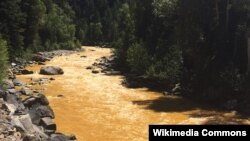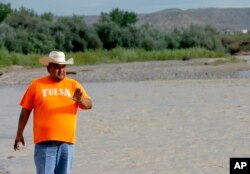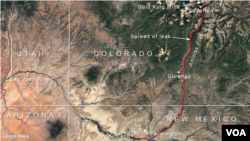The Native American Navajo Nation has accused the Obama administration of failing to clean up the damage from a toxic mine spill caused by one of its own government agencies.
In August 2015, U.S. Environmental Protection Agency (EPA) contractors assessing a leak at the site of Colorado’s long-defunct Gold King Mine inadvertently broke through earth that was holding back waste water. An estimated 11.5 million liters of water carrying about 400,000 kilograms of heavy metals spilled into the nearby Animas River, then into the San Juan River, which flows through 320 kilometers of Navajo sovereign territory.
In addition, the spill contaminated waterways serving three western states: Colorado, Utah and New Mexico.
Exposed to air, iron sulfide in the water formed sulfuric acid, turning the water a bright mustard yellow.
“The Navajo Nation’s water supply has been severely compromised as a result of the spill,” said Navajo Nation Attorney General Ethel Branch. “Tragically, we won’t know the full extent of the impacts the heavy metals released in the spill will have on our people for some time because those impacts generally only become observable in the long term.”
Branch said the Navajo government has spent millions of dollars responding to the crisis. “To mitigate the damage just to the water supply, not to mention long-term health needs and other impacts, it will cost well over $100 million for alternative water supply systems, additional water treatment, and long-term monitoring,” she said.
Earlier this month, Navajo Nation lawyers submitted a claim for more than $160 million to cover unreimbursed costs incurred in the immediate aftermath of the spill, as well as long-term medical care and monitoring and testing of soil, groundwater, crops and livestock. The claim also allows for the construction and operation of alternative water supply and treatment systems for affected areas.
The EPA admits responsibility for the spill, but has rejected all but $602,000 of those claims on the grounds that on August 19, 2015, just two weeks after the spill, it tested the San Juan River and found metal concentrations had returned to “pre-event” levels.
The EPA says that it has spent more than $29 million to address the mine incident, including more than $2 million in Clean Water Act grants and more than $3.5 million in reimbursements for emergency response expenses under the Comprehensive Environmental Response, Compensation, and Liability Act, commonly known as the "Superfund.”
“The EPA’s evaluation of costs is consistent with the agency’s legal authorities and the requirements under the Superfund,” an EPA spokesperson told VOA. “The agency can only reimburse documented and allowable incurred response costs submitted by government partners."
In May, the state of New Mexico also filed suit against the EPA, alleging injuries from the spill, as well as against the state of Colorado, the site of the 127-year-old mine, which shut down in 1922. Utah is also considering suing the EPA.
Branch said the Navajo Nation will appeal the EPA decision by the early January 2017 deadline. She expressed disappointment in President Barack Obama.
“The Obama administration’s response has reinforced the message that Native lives don’t matter,” Branch said. “And the EPA has focused their energy on minimizing potential legal liability to themselves, rather than ensuring cleanup and protection of the environment.”
In the meantime, Navajo who rely heavily on farming for their livelihood continue to be haunted by the threat of exposure to cadmium, lead, arsenic and other heavy metals.
“They are afraid to water their soil with potentially contaminated water, with yet unknown health effects,” added Branch. “They are afraid to eat the fruits and vegetables that are watered from the river. ... They are afraid to eat their sheep and cattle who have watered from the river.”
And every growing season, Branch says farmers must re-live the trauma. Where once, they would pray for rain, now they worry that the “poison” lying at the bottom of the river will be dislodged when the rain begins to fall.









